To begin, I must point out that I am no expert runner. But over the last 12 months I have gone from a 14stone 'couch potato', to a 10stone 3lbs, 13km-a-day runner. This is my story.
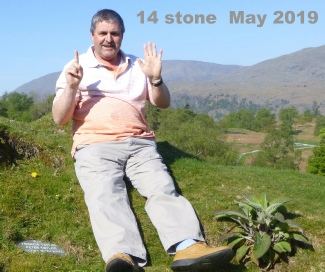 In July 2019, aged 60, I was diagnosed with type 2 diabetes. I needed to take action, deciding that a strict 800 calorie/day diet for 12 weeks, combined with daily exercise would hopefully, put my diabetes into remission. As far as the diet was concerned, I gave up sugar, so no eating chocolates, no biscuits and no cakes. I also stopped eating bread. The calorie intake was reduced by avoiding a breakfast and having one main meal of meat and two veg with a glass of fresh orange juice. I did eat as much fresh fruit as I wanted and nuts as a snack. On Sundays I gave my diet a day off!
In July 2019, aged 60, I was diagnosed with type 2 diabetes. I needed to take action, deciding that a strict 800 calorie/day diet for 12 weeks, combined with daily exercise would hopefully, put my diabetes into remission. As far as the diet was concerned, I gave up sugar, so no eating chocolates, no biscuits and no cakes. I also stopped eating bread. The calorie intake was reduced by avoiding a breakfast and having one main meal of meat and two veg with a glass of fresh orange juice. I did eat as much fresh fruit as I wanted and nuts as a snack. On Sundays I gave my diet a day off!
In the beginning, my exercise consisted of 150 yards of running (in normal shoes) until breathless, then a 100 yard walk followed by running again for a total of around 4km a day, every day. As the days went by I tried to run at bit further for each section. Within six weeks or so, I found I could run around 2km without stopping. Unbeknown to me at the time, I was in fact doing the 'Couch to 5k' running plan - and the weight came off. I lost around 20lbs in the first 3 months. I’m told that most of any initial weight loss is water so you’ll find you lose weight quickly to begin with then hit ‘plateaus’ where weight loss slows down.
At the end of September 2019, with the darker, colder, wetter mornings, running outside lost its appeal and I did what I thought I would never do and joined the local gym! I was determined not to pile the weight back on over the winter period. So the gym it was, alternating with weight training one day and cardio (rowing machine, cross trainer and running on the treadmill) the next day. I aimed for at least 800 calories burned on the cardio days. My weight continued to drop although slower and steadier; apparently I was losing fat and gaining muscle!
On 23 March 2020 the gym was closed due to the Coronavirus lockdown. I had already decided it was not worth the risk the previous week and re started my outdoor running. I soon found I could run further, faster and for longer than last summer. So I decided to attempt running 1,000km in 100 days and whilst doing so, fundraising for charity. How hard could it be? I already ran a few kilometres most days anyway. But it is quite a gruelling schedule, an average of 10km (6.2miles) each day. For those that cannot visualise kilometres, 1,000km is 621 miles and about:
- London to Copenhagen or London to Berlin.
- Equivalent to London to Manchester (and back) TWICE!
- Lands End to John O’Groats (but as the crow flies!)
- Around 24 marathons
- Chichester to Inverness (610miles)
Running shoes
Buy the best shoes you can afford. The lighter the better. You will need a size larger as your feet swell and socks are thicker. Many runners have lost toenails because their shoes were too small. I would also recommend having a video gait analysis. 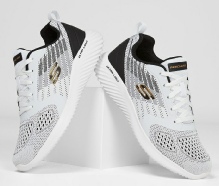 This involves running barefoot on the treadmill for a couple of minutes while a video is recorded using a gait analysis program. This is especially important if buying expensive running shoes. Running shoes being the most important piece of equipment for any type or level of runner. Gait analysis provides runners with essential information about their running style; the major focus of this is to measure the degree of pronation. Pronation is the inward roll as the outside part of the heel strikes the ground. This acts as a shock absorber for the leg and the body, which helps to distribute the force of impact. There are different degrees of pronation - Underpronation (Supination) - where the feet don’t roll inward enough and Overpronation - when the feet roll inward too much. I started out running in street shoes and bought a £24 pair of Slazenger Classic from SportsDirect. But you get what you pay for, I am now running in Sketchers Bounder Verkonas (£54).
This involves running barefoot on the treadmill for a couple of minutes while a video is recorded using a gait analysis program. This is especially important if buying expensive running shoes. Running shoes being the most important piece of equipment for any type or level of runner. Gait analysis provides runners with essential information about their running style; the major focus of this is to measure the degree of pronation. Pronation is the inward roll as the outside part of the heel strikes the ground. This acts as a shock absorber for the leg and the body, which helps to distribute the force of impact. There are different degrees of pronation - Underpronation (Supination) - where the feet don’t roll inward enough and Overpronation - when the feet roll inward too much. I started out running in street shoes and bought a £24 pair of Slazenger Classic from SportsDirect. But you get what you pay for, I am now running in Sketchers Bounder Verkonas (£54).
I decided on 1,000km in 100days (1,000miles being beyond me) as Premier League footballers (half my age!) complain about playing three matches in 7 days, covering (walking and running) a distance of circa 10km each game over 90 minutes with a 20 minute break halfway! In short I wanted to make a point.
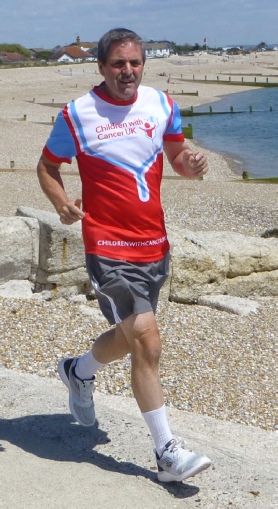 On 14 July I completed my 1,000km on calendar day 92 – 8 days early. I covered the 1,000km in just 77 running days, with and average speed of 9km/hr and in the process, I had burned 78,000 calories and lost a further 11lbs in weight being now at 10stone 3lbs.
On 14 July I completed my 1,000km on calendar day 92 – 8 days early. I covered the 1,000km in just 77 running days, with and average speed of 9km/hr and in the process, I had burned 78,000 calories and lost a further 11lbs in weight being now at 10stone 3lbs.
Running 1,000km in 100 days was a huge commitment, especially in time. I found I ran for around 90 minutes most days, which needed to be sustained over more than three months. Getting up every morning at 5am to run before it got too hot and to avoid the majority of the dog walkers. Battling high winds straight off the sea, running like Usain Bolt one way and strongman Eddie Hall towing a truck in the opposite direction back.
Would I do it again? No. Am I glad I did it? Definitely.
In (hopefully) many years to come when asked in my care home, what did you do in the great virus lockdown of 2020? I can say I ran 1,000km in 100days for charity. I must admit I never thought at 61 I could do something like this.
Some mornings after a longer run (15km or more) I spent the day walking around like John Wayne after a long horse ride. Other times when my legs ached really bad, if I had been his horse he would have probably shot me!
Tips and advice
Whether you are reading this new to running, or have been running for a long time, I hope some of the following might be useful:I would recommend wearing baggy shorts and a light T-shirt, unless the temperature is below 9degC. A low cost waist band to house your mobile phone and house keys is useful. I prefer long thick knit sports socks. Children with Cancer kindly sent me their "Technical" T-shirt which is very light and excellent at keeping me cool and reduced wind resistance. You will need around 2-3 tissues for blowing your nose. Who knew?
I also carry my patented black bin bag, with holes cut for eyes and mouth so I can shelter from a downpour. Once you have been caught in the rain, you’ll do the same!
Music and stable headphones will help you run further, for longer and faster. I like over ear headphones which also keep your ears warm on colder days. Choose fast beat workout type pop music such as "Born to be alive" - "Just can’t get enough" rather than slower pop songs.
Download a running app, which will enable you to record your run distance and other useful statistics like calories burned, speed, duration etc. using the phone GPS.
I use the https://run-log.com app. The Strava app is also quite good.
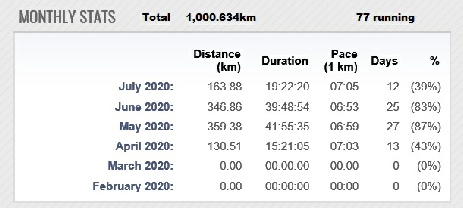
Warm up and warm down
Like many beginners, I just went out and ran. Big mistake! Luckily I avoided serious injury due to not warming up or doing warming down stretching exercises, but I did not avoid pain (see below). Warming up can consist of as little as 5 to 10 minutes of brisk walking or gentle jogging before you start to warm your muscles up and prevent injury. I also do warm up stretching before I leave, I found these warm up exercises to be the most useful for hamstring, thigh and ITB stretches. Other warm up guide here and here.
I find it is best to take the first kilometre easy with short runs followed by a few walking paces. Thereafter my running gets easier and after 4km, I often feel I can run all day.
More serious long distance/marathon runners may find this four minute warm up routine useful.
Injuries
Knee pain and other running injuries. In the first two weeks, I suffered from Iliotibial Band Syndrome (ITBS) which is very painful and without rest can get worse and take months to ease. I stopped straight away, researched it and bought some special insoles Pro II Well Being (£6.95 from Amazon) which stopped it.
Four causes of knee injury and how to fix them.
I also had calf strain, cramp, thigh strains and perhaps the most consistent and painful being pain in my feet. I now have "Tailors Bunion" in both little toes, and the start of a bunion on my right foot. All of which I had before, but didn’t know and were made worse early on by my SportsDirect Slazenger trainers being a close fit. Nothing medically can be done except hack bit of the bone away and that’s not happening. Near the end of the 1,000km my knees started to ache for the first time. I even ran 20km on one day (a half marathon) as I wanted to see if I could.
I found that my new pair of Sketchers Bounder Verkona, whilst wearing poorly on the heel (may only last 500km) are very comfortable and have eased the foot pain altogether. They also have memory foam soles that act as a shock absorber. Some of the injuries and muscle aches and pains I found I could stretch out for a few minutes and carry on with my run, other times required a hobble home and a two day rest.
Water
It is important to drink plenty of water. I wouldn’t bother with the energy drinks as they are full of sugar or sugar substitute. There is nothing as refreshing as a cold, still spring water. Despite my 1,000km in 100days schedule it was vital to factor in some rest days, a minimum of 1 in 7 days, which I tried to coincide with the worst of the weather, too hot, rain, or high winds. Obviously this meant I needed to make up the 10km not clocked up during my rest days with extra distance on running days. During the 1,000 I averaged around 12.35km each running day.
I found running in the early morning, between 5am and 8am much easier than once it gets warmer. It is also more peaceful and there are less people and traffic around. For some reason I found it much harder to run later in the day and evenings. I think it is a sign of madness to start a run if it is already raining although I did get caught in heavy rain but just 3 times in 77 running days. 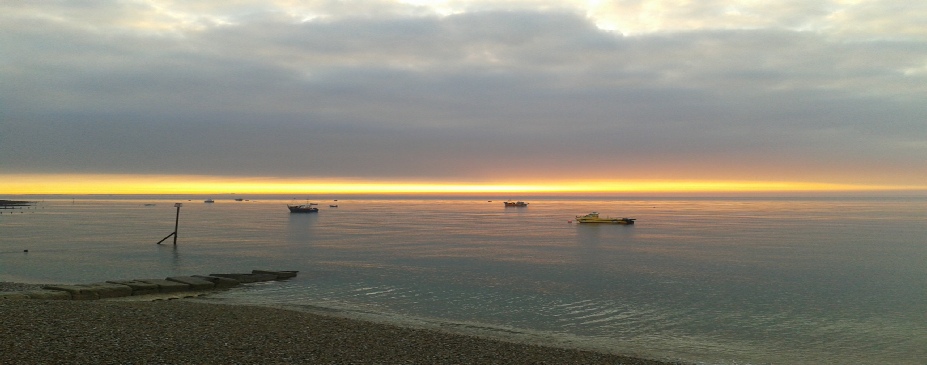
Have a strong coffee before you run, but be sure to do so at least 20 minutes before your run in case you need the toilet! Coffee somehow helps makes the running easier, I have no idea why or how but it does, believe me.
Try to stick to level, even ground. Forest trails and sports fields may have hidden ruts which may cause injury. Watch out for potholes and uneven footpaths if road running and try to avoid camber or slope. I also never run downhill at all.
Watch out for what I believe is the "runner’s curse" - dog mess! Despite byelaws, a few dog owners will knowingly and deliberately leave dog mess especially early mornings on your route. Even more bemusing, they pick it up, bag it and don't bin the bags! Also watch out for uncontrolled dogs not on a lead, that have the potential to pose a danger and be wary of all dogs, even their leads can trip you up as you pass.
If you run the same route regularly, try to say hello and smile to everyone you pass. Many will reciprocate and it will make the run more pleasurable. Most will also give way to enable you to continue without having to stop. In time I found I started conversations with some as they become curious and impressed with my running and dedication. I always raise a hand and smile to fellow runners as a mark of mutual respect.
So I managed the 1,000km in less than the 100 days and also avoided crippling myself for life. I did find around the 700km mark it was harder to motivate myself and get up and get out each day. It did get easier as I approached the last 100km and I began finding myself thinking of the next challenge I was going to do, after a week off of course. It took a great deal of time nearly every day, over three months. We had a few glasses of bucks fizz on the beach at the end of the last kilometre for those that donated and raised a further £300 in cash donations on the day.
For those that may be interested the world record for running 1,000km is:
Men: 5 days 16 hrs 17mins - Yiannis Kouros (Greece) who ran it 26 Nov to 2 Dec in 1984 in Australia.
Women: 7 days 16hrs and 8mins - Paula Mairer (Austria) who ran it 29 Sept to 6 Oct 2002 in New York. Amazing!
Overall I raised over £1,733 for Children with Cancer UK. Way short of my £5,000 target. But I didn't factor in the indifference of people that didn’t actually know me. They were donating for a children’s cancer charity after all, not my costs for doing this running challenge. Yet donations remained a disappointment to me no matter how much nudging I did on social media. Local supermarket managers (Asda, One Stop & Southern CoOp) weren't interested in corporate opportunity, neither were the suppliers of my sportswear (SportsDirect & Sketchers). I had tried several times to get the media involved especially as I had extensive contacts in national press and after being on TV but to no avail.
Most disappointing, was the disinterest of local news, BBC South Today, more especially as weather presenter Alexis Green is a keen runner herself. Unfortunately if it wasn't 'Coronavirus' they weren't interested. The fundraising, if I am honest, proved harder and more time consuming than the actual running challenge itself.
Daily running distance data 1,000km in 100days
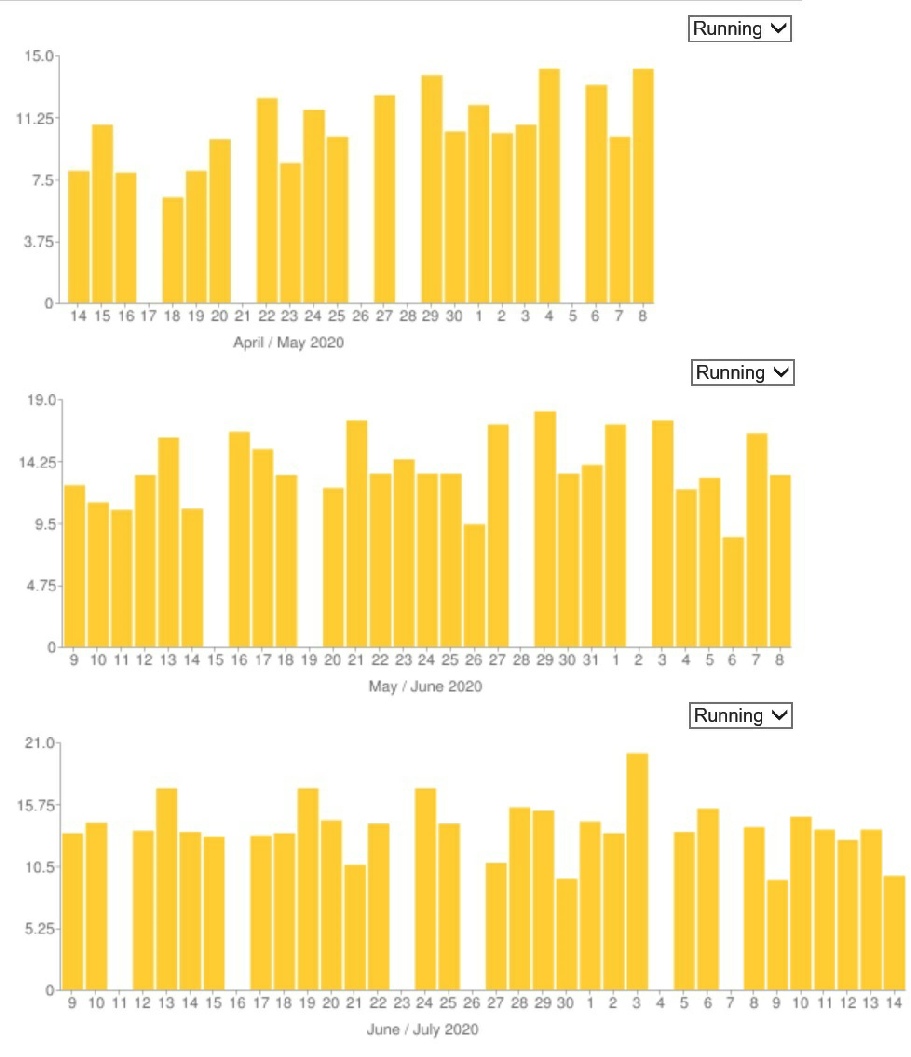
I was 23rd in the World for distance on Run-Log.com for June 2020 with 346km.
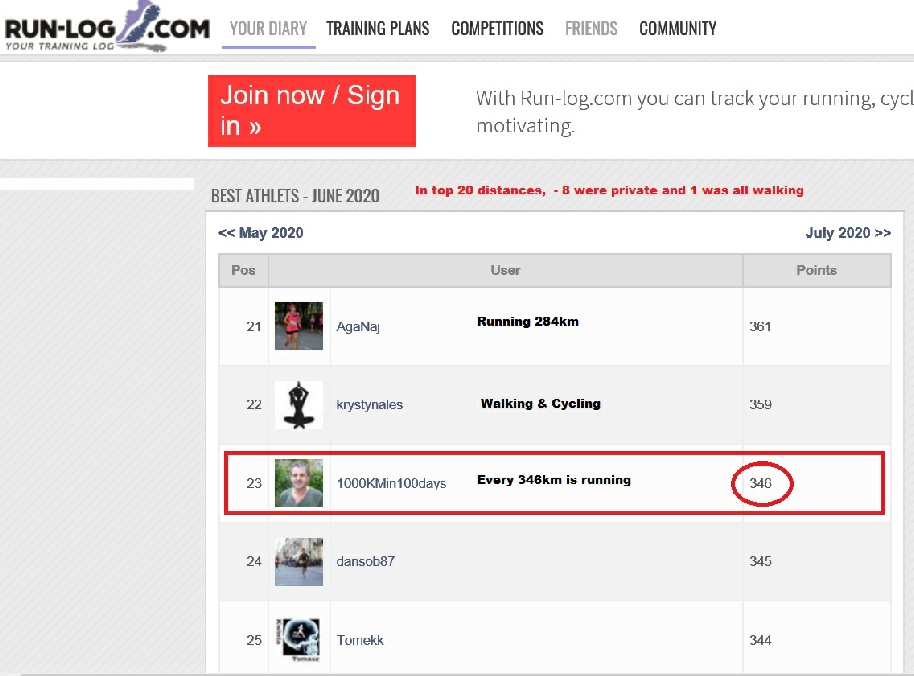










 In July 2019, aged 60, I was diagnosed with type 2 diabetes. I needed to take action, deciding that a strict 800 calorie/day diet for 12 weeks, combined with daily exercise would hopefully, put my diabetes into remission. As far as the diet was concerned, I gave up sugar, so no eating chocolates, no biscuits and no cakes. I also stopped eating bread. The calorie intake was reduced by avoiding a breakfast and having one main meal of meat and two veg with a glass of fresh orange juice. I did eat as much fresh fruit as I wanted and nuts as a snack. On Sundays I gave my diet a day off!
In July 2019, aged 60, I was diagnosed with type 2 diabetes. I needed to take action, deciding that a strict 800 calorie/day diet for 12 weeks, combined with daily exercise would hopefully, put my diabetes into remission. As far as the diet was concerned, I gave up sugar, so no eating chocolates, no biscuits and no cakes. I also stopped eating bread. The calorie intake was reduced by avoiding a breakfast and having one main meal of meat and two veg with a glass of fresh orange juice. I did eat as much fresh fruit as I wanted and nuts as a snack. On Sundays I gave my diet a day off!  This
This  On 14 July I completed my 1,000km on calendar day 92 – 8 days early. I covered the 1,000km in just 77 running days, with and average speed of 9km/hr and in the process, I had burned 78,000 calories and lost a further 11lbs in weight being now at 10stone 3lbs.
On 14 July I completed my 1,000km on calendar day 92 – 8 days early. I covered the 1,000km in just 77 running days, with and average speed of 9km/hr and in the process, I had burned 78,000 calories and lost a further 11lbs in weight being now at 10stone 3lbs. 


